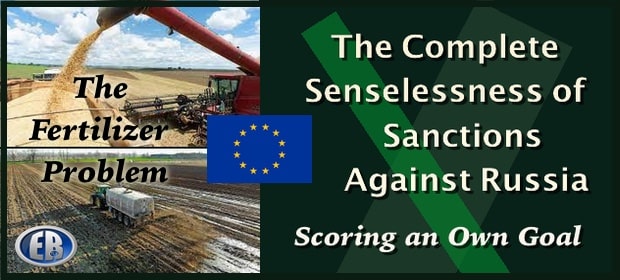
ER Editor: In relation to India also being dependent on Russian fertilizer, see India Is Mulling Rupee-Ruble Payments System For Trade With Russia.
As interesting as this article is, it does not address the basic question of why on earth the EU is engaging in these ultimately self-defeating sanctions against Russia.
********
Dependence on Russian fertilizers, a thorn in European soil
VIA FRANCE SOIR

The Uralkali factory, a Russian fertilizer company in Berezniki, in the Urals, more than 1,200 kilometers east of Moscow, on May 28, 2013
The first shock was that of the outbreak of grains and oils, the second is that of fertilizers: the war in Ukraine cast a harsh light on the dependence of European agriculture on Russian gas, the first ingredient of synthetic fertilizers.
The Russian government has already recommended that its fertilizer producers suspend their exports. The stakes are high for the European Union, which imports both gas and fertilizer from Russia.
What is Fertilizer?
Fertilizers contain nutrients to nourish plants and promote their development. They can be of organic origin (nettle manure, slurry, chicken droppings, etc.) or of mineral origin: made from nitrogen (N) in the air or minerals extracted from the subsoil, such as phosphorus (P) and potash (K).
The vast majority of European farmers use “NPK” mineral fertilisers, particularly nitrogen ones. The International Fertilizer Association (IFA), which brings together the global fertilizer industry, estimates that 85% of soils in the world lack nitrogen, an element “engine of plant growth”.
Nitrogen fertilizers are made from ammonia, obtained by combining nitrogen from the air and hydrogen from natural gas. Nearly 80% of the cost of producing ammonia is linked to the use of gas. There are several types of these fertilizers: in liquid form (nitrogen solution) or granules (ammonium nitrate and urea).
A double dependence
“In 2021, Russia was the leading exporter of nitrogen fertilizers and the second largest supplier of potassium and phosphorus fertilizers,” recalls the Food and Agriculture Organization of the United Nations (FAO).
“40% of European gas supply currently comes from Russia”, which provides “25% of European supply” in nitrogen, potash and phosphate, warned on March 1 Svein Tore Holsether, boss of the Norwegian Yara, the first producer world of mineral nitrogen fertilizers.
The European Union consumes “more than 11 million tonnes of synthetic nitrogen” every year according to a recent report by Green MEPs. It therefore depends on Russia both for its gas and its direct imports of fertilizers, Brazil remaining the leading importer of Russian nitrogen fertilizers.
Price spike continues
The price of mineral fertilizers has continued to rise, in the wake of the surge in natural gas. “Prices of urea, a key nitrogen fertilizer, have more than tripled in the last twelve months,” according to the FAO.
The Russian invasion in Ukraine has again boosted the price of gas and the nitrogen solution, which cost around 600 euros per ton at the end of October on the European market, has now reached 800 euros, “a record”, underlines Isaure Perrot, consultant at the Agritel office.
Under these conditions, Yara announced that it was temporarily reducing its production in France and Italy, and its president considered it “crucial” that the international community “work to reduce dependence on Russia”.
The possible risk of a shortage is still supplanted by the fear of supply capacities in view of the astronomical costs of fertilisers: “In Western Europe, farmers are generally covered for spring sowing, but the question arises for the 2023 campaign”, alert Edward de Saint-Denis, broker at Plantureux and associates.
Today, and “despite the rise in cereal prices, it is not profitable to buy fertilizer at 800 euros per tonne”, adds Isaure Perrot.
What solutions?
Europe will have to turn to other sources: “There is gas in Algeria, in the United States – but at what price? – and also in Iran or Kazakhstan – but will we want to buy from these countries?”, asks Ms. Perrot.
For potash, nearly 40% of which is imported from Russia and Bielorussia, Europe could turn to Canada, which is already its main supplier, but at higher prices, or to Israel and Jordan, believe grain brokers.
The EU could also increase its phosphate inputs, of which China, Morocco and the United States are the main producers, but, he stresses, this will not replace nitrogen, on which high European yields are based.
For Isaure Perrot, alternative avenues will be dug if the crisis persists, such as a modification of crops, favoring legumes, sunflower or soybeans, which consume less nitrogen than wheat and corn.
For its part, Yara wants, from 2023, to produce 30% of its ammonitrates from the hydrolysis of water – and not gas. A “green hydrogen” still very expensive but which would make it possible to overcome both fossil fuels and dependence on Russian gas.
************
Source

••••
The Liberty Beacon Project is now expanding at a near exponential rate, and for this we are grateful and excited! But we must also be practical. For 7 years we have not asked for any donations, and have built this project with our own funds as we grew. We are now experiencing ever increasing growing pains due to the large number of websites and projects we represent. So we have just installed donation buttons on our websites and ask that you consider this when you visit them. Nothing is too small. We thank you for all your support and your considerations … (TLB)
••••
Comment Policy: As a privately owned web site, we reserve the right to remove comments that contain spam, advertising, vulgarity, threats of violence, racism, or personal/abusive attacks on other users. This also applies to trolling, the use of more than one alias, or just intentional mischief. Enforcement of this policy is at the discretion of this websites administrators. Repeat offenders may be blocked or permanently banned without prior warning.
••••
Disclaimer: TLB websites contain copyrighted material the use of which has not always been specifically authorized by the copyright owner. We are making such material available to our readers under the provisions of “fair use” in an effort to advance a better understanding of political, health, economic and social issues. The material on this site is distributed without profit to those who have expressed a prior interest in receiving it for research and educational purposes. If you wish to use copyrighted material for purposes other than “fair use” you must request permission from the copyright owner.
••••
Disclaimer: The information and opinions shared are for informational purposes only including, but not limited to, text, graphics, images and other material are not intended as medical advice or instruction. Nothing mentioned is intended to be a substitute for professional medical advice, diagnosis or treatment.




